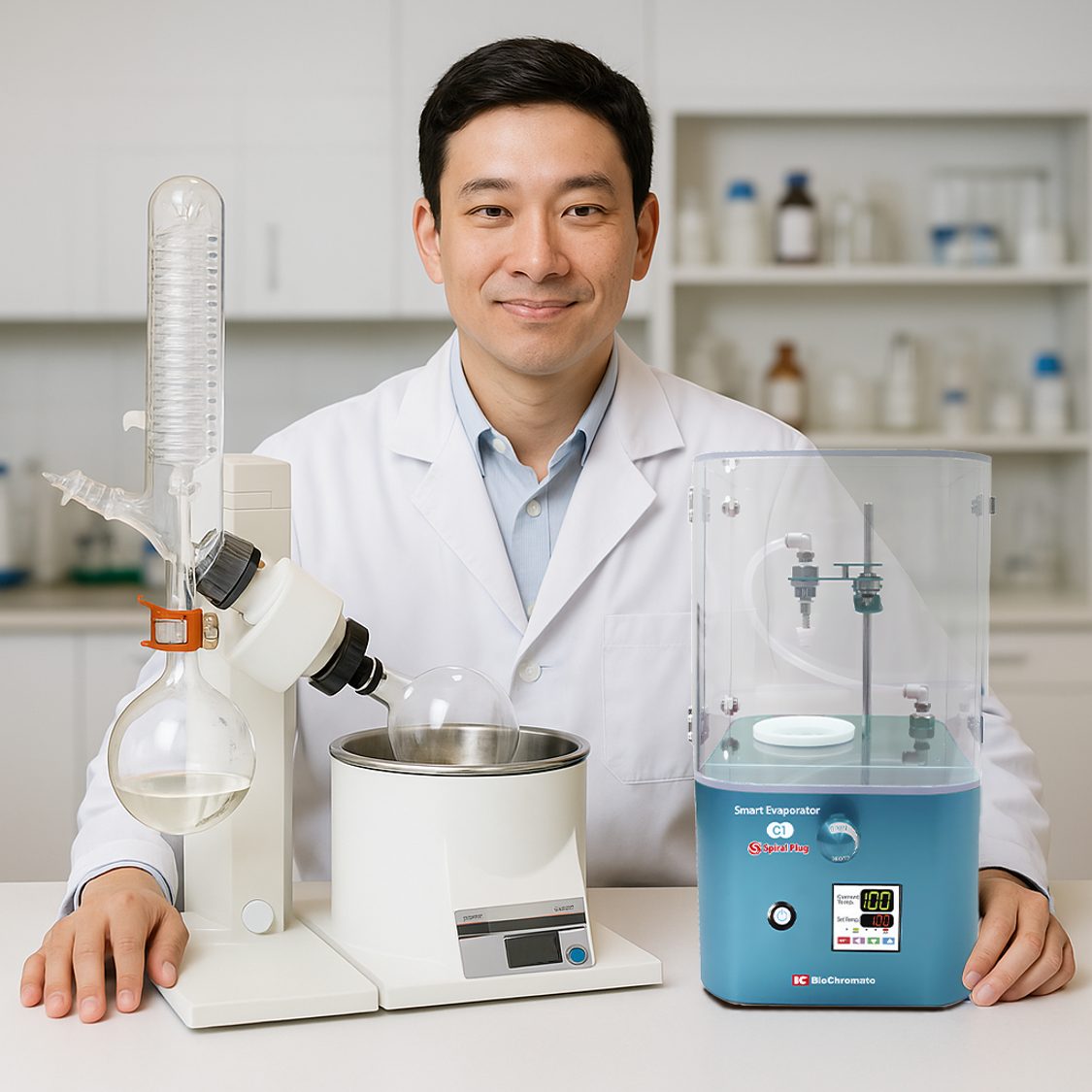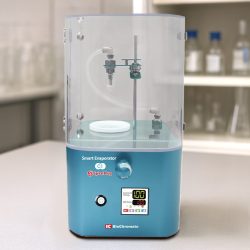Maximizing Lab Efficiency: How Smart Evaporators Complement the Rotary Standard

Rotary evaporators are a staple in laboratories around the world—reliable, familiar, and proven. But what if there were a way to make your evaporation workflows even more efficient, flexible, and safe? Enter the Smart Evaporator: a newer technology not originally designed to replace or complement the rotary evaporator, but one that can function as a highly effective counterpart when used together. While the rotary excels at handling large volumes quickly under vacuum, the smart evaporator offers a risk-free solution for small-volume, high-boiling, or heat-sensitive samples. In this article, we’ll explore the strengths of both systems, how they differ, and how using both in tandem—as many labs in Japan already do—can significantly improve your lab’s productivity and versatility.
Table of Contents
- What is a Rotary Evaporator?
- What is a Smart Evaporator?
- Rotary Evaporator vs. Smart Evaporator: Detailed Comparison
- How to Use Rotary and Smart Evaporators Together in Your Workflow
- Conclusion: Choosing the Right Evaporator for Your Research Needs
- Frequently Asked Questions (FAQ)
Ready for Safer, Faster, and More Reliable Evaporation?
What is a Rotary Evaporator?
 A rotary evaporator is a traditional laboratory device that efficiently evaporates solvents by rotating a flask under vacuum while applying heat. It is commonly used in laboratories worldwide due to its capability to rapidly process large volumes of solvents.
A rotary evaporator is a traditional laboratory device that efficiently evaporates solvents by rotating a flask under vacuum while applying heat. It is commonly used in laboratories worldwide due to its capability to rapidly process large volumes of solvents.
Key Features
- Ideal for large-scale processing
- Rapid and efficient evaporation
- Precise temperature control
- Versatile across many applications
Typical Applications
- Scale-up in organic synthesis
- Rapid processing of large sample volumes
- General laboratory use
What is a Smart Evaporator?
 A Smart Evaporator employs unique airflow and vortex technologies that allow efficient and safe concentration of samples under atmospheric pressure without the risk of bumping. Unlike traditional evaporation devices, Smart Evaporators do not require specialized containers, making them extremely versatile and easy to use.
A Smart Evaporator employs unique airflow and vortex technologies that allow efficient and safe concentration of samples under atmospheric pressure without the risk of bumping. Unlike traditional evaporation devices, Smart Evaporators do not require specialized containers, making them extremely versatile and easy to use.
Key Features
- Eliminates bumping risks, ensuring safety
- Compatible with various containers without specialized equipment
- Ideal for processing small to medium sample volumes (typically 1–50 mL)
- Intuitive and user-friendly operation
Typical Applications
- Concentration of high-boiling solvents or heat-sensitive samples
- Efficient handling of diverse, small-volume samples
- Safe concentration of pharmaceuticals and sensitive materials
Ready for Safer, Faster, and More Reliable Evaporation?
Rotary Evaporator vs. Smart Evaporator: Detailed Comparison
Processing Capacity
- Rotary Evaporator: Large volumes (hundreds of milliliters to several liters)
- Smart Evaporator: Small to medium volumes (1 to 50 mL)
Safety Considerations
- Rotary Evaporator: Bumping risks under vacuum
- Smart Evaporator: No bumping risks (operates at atmospheric pressure)
Operation and Maintenance
- Rotary Evaporator: Complex, requires regular maintenance and operator training
- Smart Evaporator: Simple design, minimal maintenance, intuitive to operate
Cost Efficiency
- Rotary Evaporator: Higher initial investment and maintenance costs
- Smart Evaporator: Lower operational and maintenance costs, cost-effective over time
Typical Applications
- Rotary Evaporator: Organic synthesis, rapid large-scale solvent evaporation
- Smart Evaporator: High-boiling solvents, heat-sensitive materials, pharmaceutical applications
How to Use Rotary and Smart Evaporators Together in Your Workflow
While rotary evaporators and Smart Evaporators each excel in different areas, their combined use can significantly optimize your lab workflow. Here are a few practical examples of how researchers integrate both systems:
- Large-volume solvent removal: Use the rotary evaporator for quick evaporation of low-boiling-point solvents in multi-gram scale reactions.
- Small-volume, high-boiling samples: Switch to the Smart Evaporator for safe and efficient concentration of small quantities of solvents such as DMSO or DMF without bumping risks.
- Parallel processing: While a rotary evaporator runs a large sample, the Smart Evaporator can simultaneously handle various small-scale samples without waiting.
- Training and turnover: New lab members can start with the simpler-to-operate Smart Evaporator, reducing the learning curve and allowing experienced users to continue using the rotary unit for advanced tasks.
In many Japanese research labs, it’s increasingly common to see both systems in place—each used where it performs best. This success has also begun to spread internationally, for example, a researcher at the University of Nottingham reported significant improvements in workflow efficiency after introducing a Smart Evaporator alongside their rotary system, and this kind of success story has begun to spread internationally. The device allowed for safer and faster processing of small-scale, high-boiling-point solvents without the risk of bumping. (Read the full testimonial here.) This smart pairing leads to improved throughput, reduced risk, and more efficient use of lab space.
Conclusion: Choosing the Right Evaporator for Your Research Needs
If your laboratory primarily processes large volumes or low-boiling-point solvents, the rotary evaporator is likely the best fit. Conversely, if you regularly handle smaller samples, high-boiling solvents, or heat-sensitive materials, a Smart Evaporator offers unmatched safety and ease of use.
However, it’s worth noting that in Japan, where the Smart Evaporator originated, many laboratories opt to use both rotary and Smart Evaporators together. This combination allows researchers to switch devices depending on the specific requirements of each task, effectively maximizing safety, efficiency, and convenience. Thus, owning both evaporators might actually be the most practical and efficient solution for many laboratories.
Selecting the appropriate device tailored to your specific research or operational objectives—or even combining both—ensures a safer and more efficient laboratory environment.
Ready for Safer, Faster, and More Reliable Evaporation?
Frequently Asked Questions (FAQ)
Q1. Can I use a rotary evaporator for high-boiling solvents?
Rotary evaporators are suitable but require careful temperature and pressure control. The Smart Evaporator is recommended for ease and safety.
Q2. Do Smart Evaporators require specialized training?
No, Smart Evaporators are intuitive and easy to operate, requiring minimal training compared to rotary evaporators.
Q3. Which evaporator has lower operational costs?
Smart Evaporators generally have lower running and maintenance costs, making them cost-effective for long-term use.
Q4. Can Smart Evaporators process large volumes?
Smart Evaporators are best suited for volumes ranging from 1 to 50 mL. For larger volumes, rotary evaporators are more efficient.
Q5. What kind of maintenance is required for Rotary and Smart Evaporators?
Rotary evaporators have a more complex structure and require regular care. Key maintenance tasks include:
- Inspecting and replacing O-rings and vacuum seals
- Greasing glass joints to ensure airtight seals
- Cleaning the condenser and receiving flask
- Maintaining the vacuum pump (e.g., oil changes or diaphragm checks)
These steps are necessary to ensure safe, efficient operation over time.
Smart Evaporators, in contrast, require minimal maintenance:
- Occasional cleaning of the Spiral Plug (Teflon stopper)
- If needed, replacing tubing that has absorbed splashes or deformed
With normal use and care to avoid sample splashes, internal parts may last for years without replacement—ideal for labs seeking low-maintenance solutions.
Ready for Safer, Faster, and More Reliable Evaporation?
